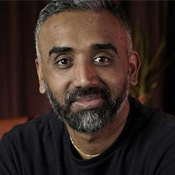Opinion
Spotify’s Rak Patel argues brands need to wake up to the power of digital audio or risk missing out where audiences are, and gives five tips to get started.
Audio provokes intense feelings. We know this from personal experience as we tune into the same podcast every week, get excited about our favourite band’s new album, or get through a breakup by streaming the same song for two weeks straight.
From 2018 to 2023, there has been a 30% increase in daily time spent listening to digital audio across the UK population.
People also have more ways to listen as they integrate devices like smart speakers, phones, tablets and more into their lives. There’s also more audio creators than ever, which means listeners can find content for almost any niche interest.
Brands are starting to carve out more of their media spend for digital audio. But it’s time to stop approaching this growing channel as experimental and get serious; otherwise, you’re missing a big portion of your audience where they are.
Digital audio offers an immersed audience
We recently shared our Sonic Science 2.0 research study, which looked at how Spotify’s deep levels of personalisation and interactivity make it a highly engaging, emotionally provoking, and memorable medium — more so than TV, digital video, and social media.
Findings from this latest study provide concrete evidence of how Spotify enhances the daily lives of listeners, and how brands can connect with audiences in their most meaningful and immersed moments. Spotify listeners are bringing audio into their lives for more than 2.4 hours every day.
From walking and reading to cooking, studying and sleeping, 63% of our study participants confirmed that Spotify is important to their daily routines.
Not only are Spotify listeners fully engaged throughout the day, but they’re also primed to embrace brand messages: 73% of participants agreed that they are open to listening to ads on audio streaming services if the tone fits what they’re doing at the time.
Given the steady increase in digital audio consumption, the influx of new content, and the undeniable audience engagement it delivers, digital audio is taking centre stage. But how can advertisers make the most of this opportunity?
A new way to create
The rules of creativity are changing constantly, and reflecting culture in your creative is more important than ever. With an immersed audience, digital audio gives brands the opportunity for their message to resonate.
Our most recent Culture Next report showed how digital audio streaming habits can be a strong predictor of Gen Zs’ attitudes and moods, and of culture at large.
Digital audio has become an essential part of Gen Z’s media diet and they turn to Spotify to fill their needs for entertainment, self-care, education, and more. In fact, Gen Zs streamed music more than any other media (including videos, games and TV) in 2021.
To effectively reach this key audience with digital audio, brands will need to learn new approaches and take inspiration from the voices defining culture today.
Some of the world’s most innovative brands like Disney+, easyJet and PepsiCo are already turning to digital audio to create original and engaging ad experiences that drive impact, but there’s still a need for marketers to recognise the scope of the opportunity with digital audio.
How to get started with digital audio
Want to get started with digital audio advertising, but don’t know how? Sharing here some tips on how to get started today:
1. Context matters. Consider who will listen to your ad. The best ads consider if the listener is a runner, a food lover… or someone who is just trying to sleep. Make the message match the mood.
2. Keep it conversational. Listeners should feel like they’re hearing about a product from a friend. Try to infuse personality or humour where possible. Talk like a human, not like a brand.
3. Stay on message. Focus on the single most important point of your ad. If there are multiple messages to communicate (for example: multiple product features), consider creating different spots to deliver one point at a time. Stick to one message per ad.
4. Time is precious. A slow cadence and well-timed pauses help listeners absorb more information. Your script should have at most four or five lines of voiceover, with no more than 60 words for 30 seconds. Use as few words as possible to make your point.
5. Show listeners the way. Give listeners a next step or destination. Whatever you want users to do — whether it’s visiting a website, listening to a podcast, using an offer code, or visiting a store — say it clearly. End with a call to action.
 Rak Patel is head of EMEA Sales at Spotify.
Rak Patel is head of EMEA Sales at Spotify.
Adwanted UK are the audio experts operating at the centre of audio trading, distribution and analytic processing. Contact us for
more information on J-ET, Audiotrack or our RAJAR data engine. To access our audio industry directory, visit
audioscape.info and to find your new job in audio visit
The Media Leader Jobs, a dedicated marketplace for media, advertising and adtech roles.





 Rak Patel is head of EMEA Sales at Spotify.
Rak Patel is head of EMEA Sales at Spotify.